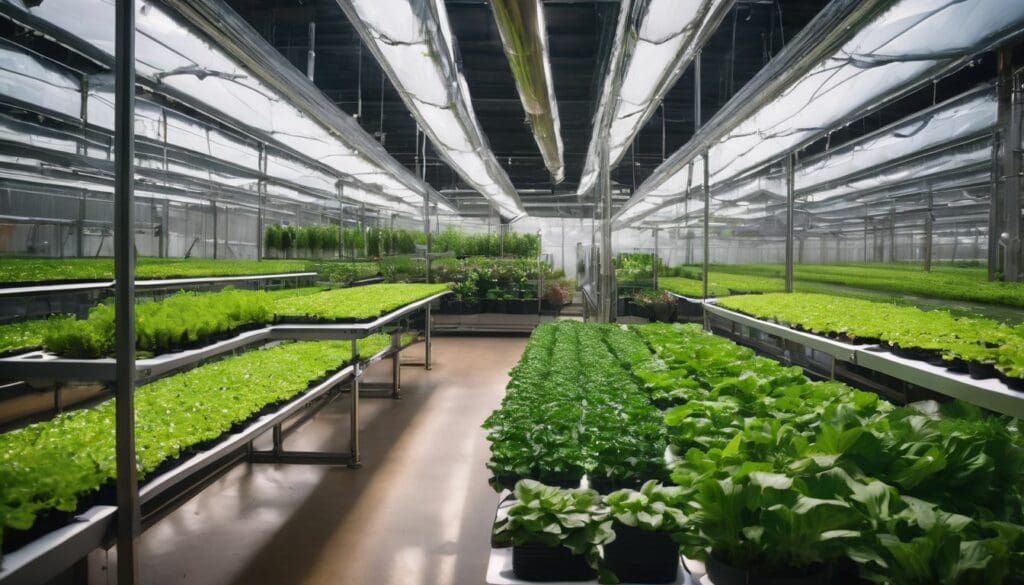Watching your garden struggle can be disheartening, especially when space and resources are scarce. Hydroponic gardening, a soilless method of growing plants, is on the rise as a revolutionary solution.
This blog post will explore how hydroponics can turn your gardening game around with minimal environmental impact whilst maximising yields. Dive in to unearth a greener future!
Key Takeaways
- Hydroponic gardening uses nutrient – rich water to grow plants, saving significant amounts of water and land compared to traditional farming methods.
- This type of gardening is ideal for urban environments where space is limited; it allows vertical farming and year-round production indoors.
- Technology plays a big part in hydroponics by enabling precise control over plant growth conditions, which leads to higher yields and more efficient resource use.
- Despite the initial set – up costs, hydroponic systems are becoming more affordable and accessible, encouraging wider adoption among individuals looking for sustainable agriculture solutions.
- With its ability to provide fresh produce close to consumption points, hydroponic farming reduces food waste and transportation emissions.
The Problem with Traditional Farming Methods
Traditional farming methods face challenges such as land and water scarcity, environmental impact, and food waste. These issues have led to the exploration of alternative farming techniques such as hydroponic gardening.
Land and water scarcity
Land and water scarcity present urgent challenges for traditional farming methods. As populations rise, the demand for food increases but the amount of available arable land does not keep pace.
Farmers are often forced to push their land beyond its limits, which can lead to soil degradation and decrease fertility. Freshwater resources also face stress from overuse in agriculture; it’s estimated that irrigation consumes about 70% of fresh water globally.
Hydroponic gardening systems offer a promising solution by using significantly less water than conventional farming practices. These innovative systems circulate nutrient-fortified water directly to plant roots, slashing the consumption of this precious resource.
Additionally, hydroponics makes it possible to grow crops in places where soil conditions are poor or non-existent – including urban environments where space is at a premium and previously unviable for crop production.
This opens up new avenues for sustainable agriculture and conservation, providing fresh produce closer to where people live with minimal environmental footprint.
Environmental impact
Hydroponic gardening offers a compelling solution to the environmental challenges posed by traditional farming. By using nutrient-fortified water and automated gardening systems, hydroponics minimises land usage and reduces water consumption compared to conventional methods.
This soilless method of cultivation also diminishes the risk of soil erosion and contamination, ultimately contributing to sustainable agriculture technology. Urban and vertical hydroponic farming further alleviate the strain on land resources while providing opportunities for localised food production, aligning with the principles of urban agriculture.
The introduction of hydroponic technology into the global market represents a significant step towards more environmentally friendly farming practices. With its potential for year-round production in controlled environments, this alternative method holds promise for supporting conservation efforts and fostering a healthier environment through reduced food transportation emissions.
Food waste
Hydroponic gardening has the potential to reduce food waste significantly. Traditional farming methods often lead to a considerable amount of produce being discarded due to factors such as pest damage, spoilage during transportation, or not meeting aesthetic standards.
By growing crops in controlled environments with hydroponic systems, the risk of these issues can be minimised, leading to less food waste and a more sustainable use of resources.
Furthermore, hydroponic gardening allows for precise monitoring of nutrient levels and water supply, reducing the likelihood of over-ripening or spoilage. This ability to carefully manage plant growth ensures that more produce reaches consumers without being wasted along the way.
What is Hydroponic Gardening?
Hydroponic gardening involves growing plants in nutrient-fortified water, without the need for soil. This innovative method eliminates the limitations of traditional farming and offers a sustainable solution to modern agricultural challenges.
Growing plants in water-based nutrient solutions
Hydroponic gardening involves growing plants in nutrient-fortified water, eliminating the need for soil. This method allows for precise control over the nutrients delivered to plants, resulting in faster growth and higher yields.
By providing an optimal environment for plant root systems, hydroponic farming reduces water usage and enables food production in urban areas where space is limited.
This innovative approach also minimises the environmental impact of traditional farming methods by decreasing land usage and potential food waste. With the ability to integrate technology and automate indoor gardening systems, hydroponic agriculture offers a sustainable solution for future food production while addressing global challenges such as land scarcity and water conservation.
Eliminating the need for soil
By growing plants in water-based nutrient solutions, hydroponic gardening eliminates the need for soil. This soilless method provides a controlled environment for plant growth, where essential nutrients are directly delivered to the roots.
Without soil as a medium, plants can absorb nutrients more efficiently and grow faster. As a result, urban areas with limited access to arable land can still produce fresh fruits and vegetables through innovative hydroponic systems.
Furthermore, the elimination of soil reduces the risk of pests and diseases that commonly affect traditional farming methods. In addition, it minimises water usage by providing a closed-loop system where water is recirculated and reused.
Reasons for the Rise of Hydroponic Gardening
The rise of hydroponic gardening is driven by the increased demand for sustainable and efficient farming methods, especially in urban areas where space is limited. Additionally, the potential for year-round production has also contributed to its popularity.
Increased demand for sustainable and efficient farming methods
The global demand for sustainable and efficient farming methods has surged in response to environmental concerns and the need for food security. Urbanisation, land scarcity, and climate change have prompted a shift towards innovative techniques like hydroponic gardening.
This method allows for the cultivation of crops using significantly less water and space compared to traditional farming, addressing key sustainability challenges while meeting the growing demand for fresh produce in urban areas.
As concerns about environmental impact continue to escalate, individuals are increasingly seeking out alternative farming methods that minimise resource usage without compromising productivity.
Ability to grow food in urban areas
Hydroponic gardening offers the ability to grow food in urban areas, addressing the challenge of limited space for traditional farming. The compact nature of hydroponic systems allows for vertical farming, making it possible to cultivate crops within city limits and even indoors.
This brings sustainable and locally grown produce closer to urban communities, reducing transportation emissions associated with bringing food from rural areas. Urban hydroponic farming aligns with the growing demand for environmentally friendly agricultural practices, contributing to a more sustainable and resilient food system.
With urban hydroponic farming methods gaining popularity, there is potential to significantly reduce the environmental impact of food production while providing fresh produce directly within cities.
Potential for year-round production
Hydroponic gardening has the potential for year-round production, allowing for consistent and reliable harvests regardless of seasonal changes. This is made possible through controlled environment agriculture techniques, such as greenhouse gardening and automated indoor gardening systems, which create an ideal climate for plant growth.
By utilising nutrient-fortified water farming, hydroponic systems enable crops to thrive in any season, addressing the need for sustainable food production in urban areas where traditional farming may be limited by space or environmental factors.
Moreover, the future of farming lies in soilless cultivation methods that support environmentally conscious individuals‘ desire for efficient and sustainable agricultural practices.
Benefits and Challenges of Hydroponic Gardening
Hydroponic gardening offers higher yields and faster growth, with reduced water and land usage, but initial investment costs can be a challenge. To discover more about the potential benefits and challenges of hydroponic gardening, continue reading.
Higher yields and faster growth
Hydroponic gardening systems yield more produce in less time compared to traditional farming. Plants grown hydroponically receive direct access to nutrients, promoting accelerated growth and increasing overall output.
This method offers a sustainable solution for environmentally conscious individuals seeking efficient agricultural practices that align with conservation efforts.
The ability of hydroponic gardening to deliver higher yields and faster growth is appealing for those looking to support sustainable agriculture. By harnessing the power of nutrient-fortified water, this soilless farming technique addresses the demand for increased food production while minimising environmental impact.
Reduced water and land usage
Transitioning from the potential for higher yields and faster growth, hydroponic gardening also offers reduced water and land usage. With this method, plants receive their nutrients directly from a nutrient-rich water solution, eliminating the need for extensive soil usage.
This significantly reduces water consumption compared to traditional farming methods that rely on continuous irrigation systems and allows for more efficient use of limited arable land in urban environments.
Implementing hydroponic gardening not only conserves precious natural resources but also enables sustainable agriculture in areas with minimal available land. By embracing nutrient-fortified water farming techniques, individuals can contribute to mitigating the environmental impact while supporting global conservation efforts – all without compromising on food production or quality.
Initial investment costs
As hydroponic gardening reduces water and land usage, it also involves initial investment costs. However, the long-term benefits outweigh these expenses. The initial setup of a hydroponic system may include purchasing equipment such as grow lights, pumps, reservoirs, and nutrient solutions.
Additionally, factors like building an indoor environment or greenhouse for year-round production might contribute to the upfront investment. Despite these costs, the potential for higher yields and efficient use of resources make it a compelling option for sustainable farming.
Moreover, with advancements in technology and increasing demand for urban farming solutions, there are various options available at different price points to suit individual needs.
The Future of Hydroponic Gardening
The future of hydroponic gardening looks promising, with the integration of technology allowing for greater efficiency and productivity. There is also potential for commercial use to expand, as improvements in accessibility and affordability make it more accessible to a wider range of growers.
Integration of technology
Hydroponic gardening is embracing technological advancements, with the integration of smart sensors and automated systems to monitor and control nutrient levels, water usage, and environmental conditions.
This technology allows for precise adjustments to optimise plant growth, leading to higher yields and resource efficiency. Additionally, the use of LED lighting has enabled year-round production in indoor hydroponic systems, further enhancing sustainability and reducing reliance on traditional farming methods.
As the hydroponic farming industry continues to evolve, technological innovations play a crucial role in expanding accessibility and affordability of nutrient-fortified water farming techniques.
These advancements open up opportunities for more individuals to participate in sustainable hydroponic agriculture practices while supporting conservation efforts for a greener future.
Potential for commercial use
Hydroponic gardening systems hold significant potential for commercial use, offering a sustainable solution to meet the increasing demand for fresh produce. With nutrient-fortified water farming, hydroponic vegetable gardening can be scaled up to supply urban markets with high-quality, locally grown fruits and vegetables.
This method allows year-round production in controlled indoor environments, reducing the reliance on traditional agricultural practices and minimising transportation costs.
The integration of technology further enhances the commercial viability of hydroponic agriculture techniques, enabling efficient monitoring and management of crops. As innovations continue to improve accessibility and affordability, the adoption of indoor hydroponic gardening systems is poised to revolutionise commercial food production while supporting conservation efforts.
Improvements in accessibility and affordability
Hydroponic gardening is becoming more accessible and affordable, making it easier for urban dwellers to grow their own fresh produce. Innovations in hydroponic systems have led to smaller, more efficient setups that can fit into tight living spaces.
This accessibility empowers individuals to take control of their food production without the need for a large garden or outdoor space.
Affordability has also improved as the demand for home hydroponic systems has increased. This surge in interest has driven competition among suppliers, resulting in cost reductions for nutrient-fortified water farming kits and equipment.
Conclusion
In conclusion, the rise of hydroponic gardening systems offers a sustainable solution to traditional farming challenges. It enables efficient and year-round food production while mitigating land and water scarcity issues.
With technology integration and improved accessibility, the future of nutrient-fortified water farming looks promising for urban areas and commercial use.
FAQs
1. What is a hydroponic gardening system?
A hydroponic gardening system is a method of growing plants using nutrient-fortified water without soil, often used for indoor vegetable gardens.
2. Why are hydroponic systems becoming more popular?
Hydroponic systems are on the rise because they allow people to grow vegetables indoors efficiently, using less space and water than traditional farming.
3. Can you grow all types of vegetables with hydroponics?
Yes, most vegetables can thrive in a hydroponic system as long as they have the right nutrient-fortified water and proper care.
4. Is it easy to start an indoor hydroponic garden?
Starting an indoor hydroponic garden requires some setup for the system and understanding how to maintain the nutrient levels in the water, but it’s quite manageable once you get going.





